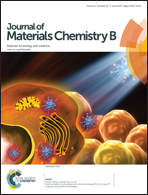Biocompatibility and osteogenic capacity of borosilicate bioactive glass scaffolds loaded with Fe3O4 magnetic nanoparticles†
Abstract
Multifunctional biocompatible scaffolds with enhanced osteogenic capacity coupled with magnetic and magnetothermal properties are of great interest for the repair of large bone defects resulting from the resection of tumors. In the present study, we created borosilicate bioactive glass (BG) scaffolds loaded with varying amounts (5–15 wt%) of Fe3O4 magnetic nanoparticles (MNPs) and evaluated their performance in vitro and in vivo. The incorporation of MNPs endowed scaffolds with excellent magnetic, controlled magnetothermal properties and higher mechanical capacity. The MNP-loaded scaffolds were not toxic to human bone marrow-derived stem cells (hBMSCs) cultured on the scaffolds in vitro. The alkaline phosphatase activity and the osteogenic gene expression of the hBMSCs increased with increasing amount of MNPs in the scaffolds. When implanted in rat calvarial defects for 8 weeks, the scaffolds loaded with 15 wt% MNPs showed a significantly better capacity to regenerate bone when compared to the scaffolds without the MNPs. These MNP-loaded BG scaffolds are promising implants for regenerating bone in defects resulting from tumor resection.


 Please wait while we load your content...
Please wait while we load your content...